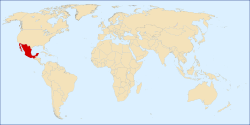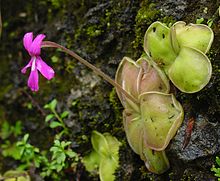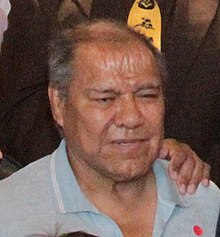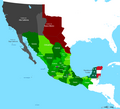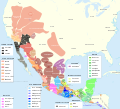Portal:Mexico
|
The Temple of Warriors at Chichen Itza, Mexico
¡Bienvenido! Welcome to the Mexico portal
Mexico, officially the United Mexican States, is a country in the southern portion of North America. It covers 1,972,550 km2 (761,610 sq mi), making it the world's 13th-largest country by area; with a population of almost 130 million, it is the 10th-most-populous country and the most populous Spanish-speaking country. Mexico is organized as a federal constitutional republic comprising 31 states and Mexico City, its capital. It shares land borders with the United States to the north, with Guatemala and Belize to the southeast; as well as maritime borders with the Pacific Ocean to the west, the Caribbean Sea to the southeast, and the Gulf of Mexico to the east.
This is a Featured article, which represents some of the best content on English Wikipedia.
Pinguicula moranensis /pɪŋˈɡwɪkjʊlə ˌmɒrəˈnɛnsɪs/ is a perennial rosette-forming insectivorous herb in the flowering plant family Lentibulariaceae. It is native to El Salvador, Guatemala, Honduras and Mexico. A species of butterwort, it forms summer rosettes of flat, succulent leaves up to 10 centimeters (4 in) long, which are covered in mucilaginous (sticky) glands that attract, trap, and digest arthropod prey. Nutrients derived from the prey are used to supplement the nutrient-poor substrate that the plant grows in. In the winter the plant forms a non-carnivorous rosette of small, fleshy leaves that conserves energy while food and moisture supplies are low. Single pink, purple, or violet flowers appear twice a year on upright stalks up to 25 centimeters long. The species was first collected by Humboldt and Bonpland on the outskirts of Mina de Morán in the Sierra de Pachuca of the modern-day Mexican state of Hidalgo on their Latin American expedition of 1799–1804. Based on these collections, Carl Sigismund Kunth described this species in Nova Genera et Species Plantarum in 1817. The extremely variable species has been redefined at least twice since, while several new species have been segregated from it based on various geographical or morphological distinctions, although the legitimacy of some of these is still debated. P. moranensis remains the most common and most widely distributed member of the Section Orcheosanthus. It has long been cultivated for its carnivorous nature and attractive flowers, and is one of the most common butterworts in cultivation. (Full article...)Selected article - The North American Free Trade Agreement (NAFTA /ˈnæftə/ NAF-tə; Spanish: Tratado de Libre Comercio de América del Norte, TLCAN; French: Accord de libre-échange nord-américain, ALÉNA) was an agreement signed by Canada, Mexico, and the United States that created a trilateral trade bloc in North America. The agreement came into force on January 1, 1994, and superseded the 1988 Canada–United States Free Trade Agreement between the United States and Canada. The NAFTA trade bloc formed one of the largest trade blocs in the world by gross domestic product. The impetus for a North American free trade zone began with U.S. president Ronald Reagan, who made the idea part of his 1980 presidential campaign. After the signing of the Canada–United States Free Trade Agreement in 1988, the administrations of U.S. president George H. W. Bush, Mexican President Carlos Salinas de Gortari, and Canadian prime minister Brian Mulroney agreed to negotiate what became NAFTA. Each submitted the agreement for ratification in their respective capitals in December 1992, but NAFTA faced significant opposition in both the United States and Canada. All three countries ratified NAFTA in 1993 after the addition of two side agreements, the North American Agreement on Labor Cooperation (NAALC) and the North American Agreement on Environmental Cooperation (NAAEC). (Full article...)Selected pictureThis is a Good article, an article that meets a core set of high editorial standards.
Arturo Díaz Mendoza (March 23, 1952 – August 21, 2018) was a Mexican professional wrestler who performed under the ring name Villano III (in Spanish Villano Tercero). Díaz was a second-generation wrestler, son of luchador Ray Mendoza and the father of professional wrestlers Villano III Jr. and El Hijo del Villano III himself. All five of the Díaz brothers used the Villano name; José de Jesús (Villano I), José Alfredo (Villano II), Tomás (Villano IV) and Raymundo (Villano V). Of the five Villanos, Arturo was considered the most successful in terms of championship and Lucha de Apuesta (bet match) wins as well as the most talented luchador in the family. He retired from wrestling in 2015 due to health issues stemming from wrestling. A few days after his death, he was inducted in the AAA Hall of Fame. During his 35-year career, Arturo Díaz was one of the featured performers for the Universal Wrestling Association, and for all the all major Mexican wrestling promotions such as Consejo Mundial de Lucha Libre and AAA as well as numerous notable smaller Mexican promotions like International Wrestling Revolution Group. Díaz was an enmascarado, or masked wrestler, up until 2000 where he lost to Atlantis and had to unmask as a result. The match against Atlantis was later voted "Match of the Year" in the Wrestling Observer Newsletter year-end awards. In contrast one of his last matches ever, at Triplemanía XXIII was voted the "worst match of the year" in 2015. (Full article...)Selected biography -Juana Inés de Asbaje y Ramírez de Santillana, better known as Sor Juana Inés de la Cruz OSH (12 November 1648 – 17 April 1695), was a colonial Mexican writer, philosopher, composer and poet of the Baroque period, as well as a Hieronymite nun, nicknamed "The Tenth Muse" and "The Phoenix of America" by her contemporary critics. As a Spanish-criolla from the New Spain, she was among the main American-born contributors to the Spanish Golden Age, alongside Juan Ruiz de Alarcón and Garcilaso de la Vega "el Inca", and is presently considered one of the most important female authors in Spanish language literature and the literature of Mexico. Throughout history Sor Juana's significance to different communities has varied significantly, having been presented as a candidate for Catholic sainthood, a symbol of Mexican nationalism, freedom of speech, women's rights, sexual diversity, and others, making her a figure of great controversy and debate to this day. (Full article...)
In the news
Selected fare or cuisine - In the United States, Mexican Coca-Cola, or Mexican Coke (Spanish: Coca Cola de Vidrio, English: Glass Coca-Cola, or Coca-Cola in a glass bottle) or, informally, "Mexicoke", refers to Coca-Cola produced in and imported from Mexico. The Mexican formula that is exported into the U.S. is sweetened with white sugar instead of the high-fructose corn syrup used in the American formula since the early 1980s. Some tasters have said that Mexican Coca-Cola tastes better, while other blind tasting tests reported no perceptible differences in flavor. Mexican Coke should not be confused with the domestic version of Coca-Cola sold in Mexico, which since 2017 may contain the artificial sweetener sucralose, with a can containing one-third less sugar than the export product. (Full article...)
General imagesThe following are images from various Mexico-related articles on Wikipedia.
CategoriesTopicsRelated portalsWikiProjectYou are invited to participate in WikiProject Mexico, a WikiProject dedicated to developing and improving articles about Mexico. Associated WikimediaMore portals | ||||||||||




